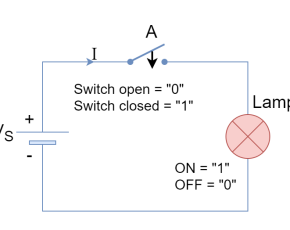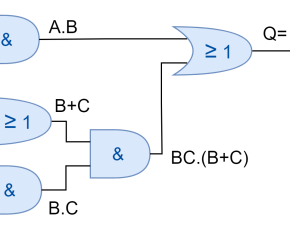Product of Sum
- Muhammad Shahid
- m_shahid@live.co.uk
- 1.206 Views
- 0 Comments
Product of Sum
In the Sum of Product article, we discussed that the Sum of Product (SOP) expression is equivalent to the logical AND-OR function. Likewise, a Product of Sum (POS) expression is equivalent to the logical OR-AND function which means it outputs the Product (AND) of two or more Sums (OR). The Product of Sum (POS) expression comprises multiple OR’ed terms which are finally AND’ed together. The sequence of logical operations leads to the equivalency of the OR-AND function of Product of Sum (POS).
The Sum (OR) Term
The logical OR function can be designated as a Sum term as it produces the sum of inputs/ variables. The OR function is similar to the sum operation of conventional mathematics and is also denoted by a plus (+) sign between operands. In expression form, it is expressed as “Q = A + B” where A & B are input variables and Q is the sum term.

The digital logic circuits use a Boolean data type having only two distinct states i.e. “0” or “1”. The states “0” and “1” are also represented by “LOW” and “HIGH”, respectively. Whereas, in switching theory, “0” and “1” are referred to as “OFF” and “ON”, respectively.
The sum terms produced by OR’ing can have either of distinct “0” or “1”, “true” or “false” state, or can be a non-complemented or complemented form of variable states. However, this leads to the OR’ed expression with one instance of each variable that is either in uncomplemented or in complemented form only and such an expression cannot be further reduced.
The sum terms are commonly known as max terms and represent the sum of all variables and/ or constants with and without inversion. The following table illustrates the possible states of the OR (Sum) function on variables and constants.
 With the application of the following laws, any Boolean sum (OR) can be reduced to a single variable or constant. A brief description of each is given and “A” represents an input variable.
With the application of the following laws, any Boolean sum (OR) can be reduced to a single variable or constant. A brief description of each is given and “A” represents an input variable.
Annulment Law
OR operation of a term with 1 is always equal to 1 i.e. A+1 = 1
Complement Law
OR operation of a term with its complement is always equal to 1 i.e. A+A’ = 1
Commutative Law
The OR operation is independent of the order of terms i.e. A+1 = 1+A
Idempotent Law
The OR operation of a term with itself is always equal to the term i.e. A+A = A
Identity Law
The OR operation of a term with 0 is always equal to the term i.e. A+0 = A
The Product (AND) Term
In Boolean Algebra, product (multiplications) means resultant/ output of AND operation. The AND function is the mathematical equivalent of multiplication. The logical inputs are AND’ed together to yield a logical output. The inputs can be variables or constants.
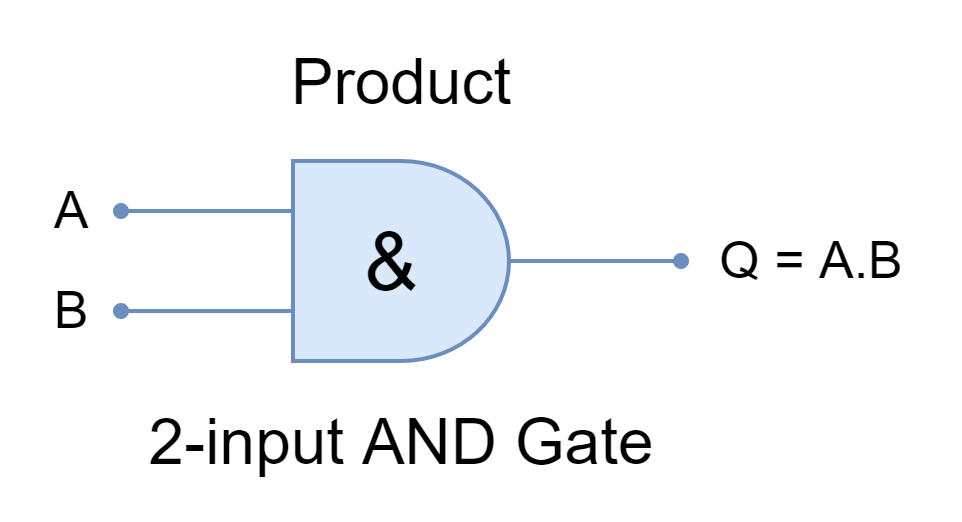
Product of Sum
In a nutshell, the OR function gives the logical sum of Boolean addition. Likewise, the AND function gives the logical product of Boolean multiplication. However, most digital circuits consist of multiple logic gates including AND, OR, and NOT gates which constitute combinational logic circuits. The combinational logic circuits are widely expressed as Sum-of-Product or Product-of-Sum as they include both AND, and OR functions, mainly.
The Product-of-Sum (POS) expresses the combinational logic as two or more sums are multiplied together. In logical terms, the outputs of two or more OR functions (constituting sums) are connected to AND function (multiplied together) to give Product-of-Sum. It is an OR-AND logic operation having two or more OR terms and only one AND term. A few examples of Product-of-Sum (POS) are given below:
 In the most cases, the Boolean expressions are given in the non-standard form of Product-of-Sum (POS) and can be converted into a standard Product-of-Sum (POS) form by applying distributive law with respect to the sum as shown below:
In the most cases, the Boolean expressions are given in the non-standard form of Product-of-Sum (POS) and can be converted into a standard Product-of-Sum (POS) form by applying distributive law with respect to the sum as shown below:
 Applying distributive law with respect to sum:
Applying distributive law with respect to sum:
 Another, non-standard POS form:
Another, non-standard POS form:
 Which can be further reduced to:
Which can be further reduced to:
 Constructing a Truth Table from Product-of-Sum (POS) Expression
Constructing a Truth Table from Product-of-Sum (POS) Expression
A truth table can be constructed from a product-of-sum expression and, conversely, a product-of-sum expression from a truth table. The sum terms in the product-of-sum expression, each produce a logic “0” for the specific input states. For example, the A+B+C term will produce a “0” state when A=1, B=1, & C=1. Similarly, A+B+C’ is “0” when A=1, B=1, & C=0. In a similar manner, the truth table is constructed for all the sum terms for the specific inputs’ states and their output is set to “0”. The output of all other states is set to “1”. Consider the following Boolean expression:
The following truth table is drawn for all of the possible states of A, B, and C. The output of the above expression is set to “0” for all the sums in terms of product-of-sum expression at their specific input states.
It is obvious from the above table that sum terms are set to “0” for that specific state of inputs and the rest of the output states are set to “1”. When any of the terms is “0” then AND (product) function sets the output to “0”.
Likewise, a Boolean product-of-sum (POS) expression can be constructed from a given truth table. Consider the following truth tables.
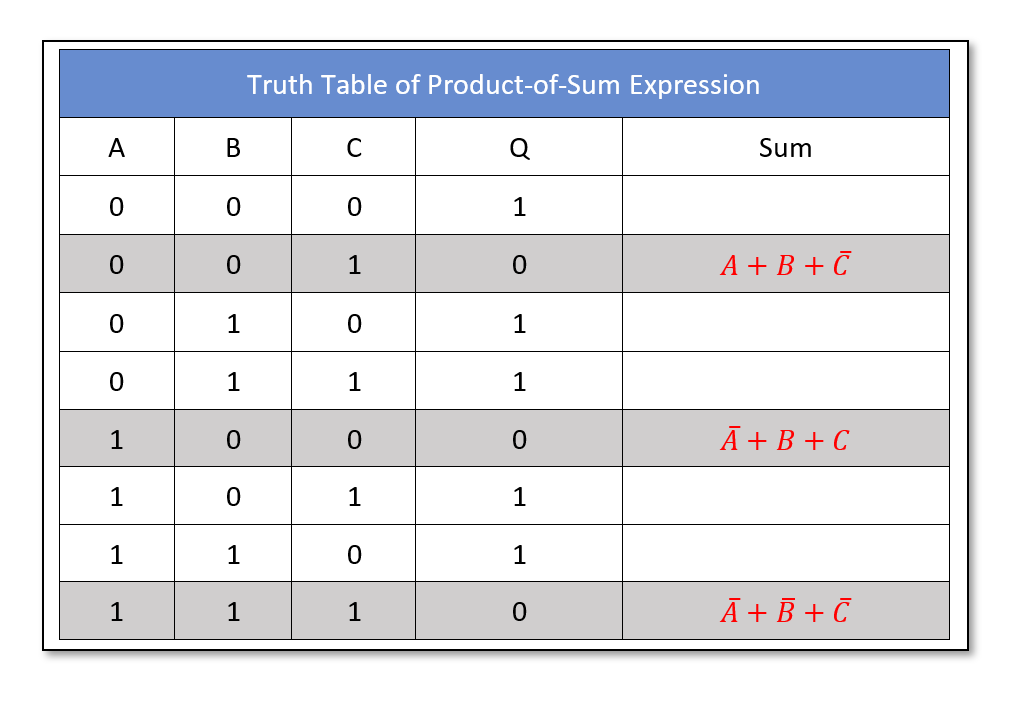 From the above truth table, the following product-of-sum expression is derived.
From the above truth table, the following product-of-sum expression is derived.
Consider the following given Boolean expression:
 If the expression is in the non-standard form of the product-of-sum then it needs to be converted into standard form before proceeding further. The given expression is in standard form.
If the expression is in the non-standard form of the product-of-sum then it needs to be converted into standard form before proceeding further. The given expression is in standard form.
The following truth table is constructed from the above product-of-sum expression.
From the given product-of-sum following logic diagram is created.
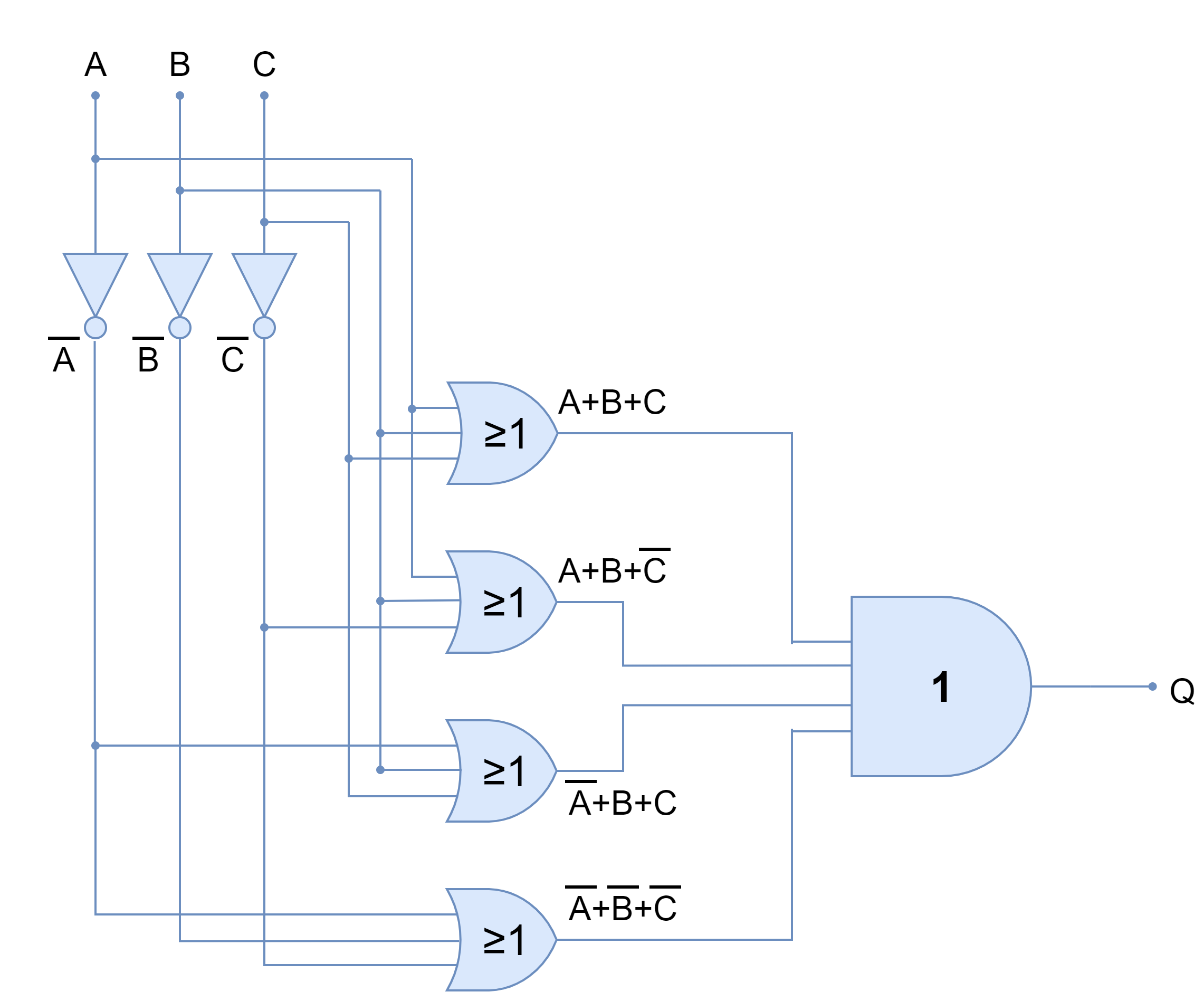
Following the above example, from any truth table, a product-of-sum expression can be derived and can ease the process of creating a logic diagram.
Conclusion
- A Product-of-Sum expression is a logical equivalent of two or more OR functions that are multiplied together. It is OR-AND logic which has more than two OR logics and only one AND logic.
- In Boolean, the logical OR function performs addition and produces a Sum. Whereas, the logical AND function performs multiplication and produces a Product. In this way, the OR-AND logic is given the name of product-of-sum.
- A maxterm is a sum term in a Boolean function in which every element is present either in complemented or in non-complemented form.
- The combinational digital circuits consist of AND, OR, and NOT logic gates and are commonly described in product-of-sum (POS).
- A truth table can be constructed easily from the given product-of-sum expression and vice versa.
- In the truth table, the outputs are set to “0” for sum terms included in the product-of-sum- expression at that specific input state only, and the rest of the outputs are set to “1”.











